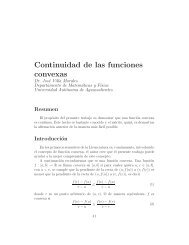Chapter 4 Linear Differential Operators
Chapter 4 Linear Differential Operators
Chapter 4 Linear Differential Operators
Create successful ePaper yourself
Turn your PDF publications into a flip-book with our unique Google optimized e-Paper software.
126 CHAPTER 4. LINEAR DIFFERENTIAL OPERATORS<br />
GaAs: m L<br />
ψ ψ<br />
L R<br />
?<br />
AlGaAs:m R<br />
Figure 4.1: Heterojunction and wavefunctions.<br />
Physics application: semiconductor heterojunction<br />
We now demonstrate why we have spent so much time on identifying selfadjoint<br />
boundary conditions: the technique is important in practical physics<br />
problems.<br />
A heterojunction is an atomically smooth interface between two related<br />
semiconductors, such as GaAs and AlxGa1−xAs, which typically possess different<br />
band-masses. We wish to describe the conduction electrons by an<br />
effective Schrödinger equation containing these band masses. What matching<br />
condition should we impose on the wavefunction ψ(x) at the interface<br />
between the two materials? A first guess is that the wavefunction must be<br />
continuous, but this is not correct because the “wavefunction” in an effectivemass<br />
band-theory Hamiltonian is not the actual wavefunction (which is continuous)<br />
but instead a slowly varying envelope function multiplying a Bloch<br />
wavefunction. The Bloch function is rapidly varying, fluctuating strongly<br />
on the scale of a single atom. Because the Bloch form of the solution is no<br />
longer valid at a discontinuity, the envelope function is not even defined in<br />
the neighbourhood of the interface, and certainly has no reason to be continuous.<br />
There must still be some linear relation beween the ψ’s in the two<br />
materials, but finding it will involve a detailed calculation on the atomic<br />
scale. In the absence of these calculations, we must use general principles to<br />
constrain the form of the relation. What are these principles?<br />
We know that, were we to do the atomic-scale calculation, the resulting<br />
connection between the right and left wavefunctions would:<br />
• be linear,<br />
• involve no more than ψ(x) and its first derivative ψ ′ (x),<br />
• make the Hamiltonian into a self-adjoint operator.<br />
We want to find the most general connection formula compatible with these<br />
x




